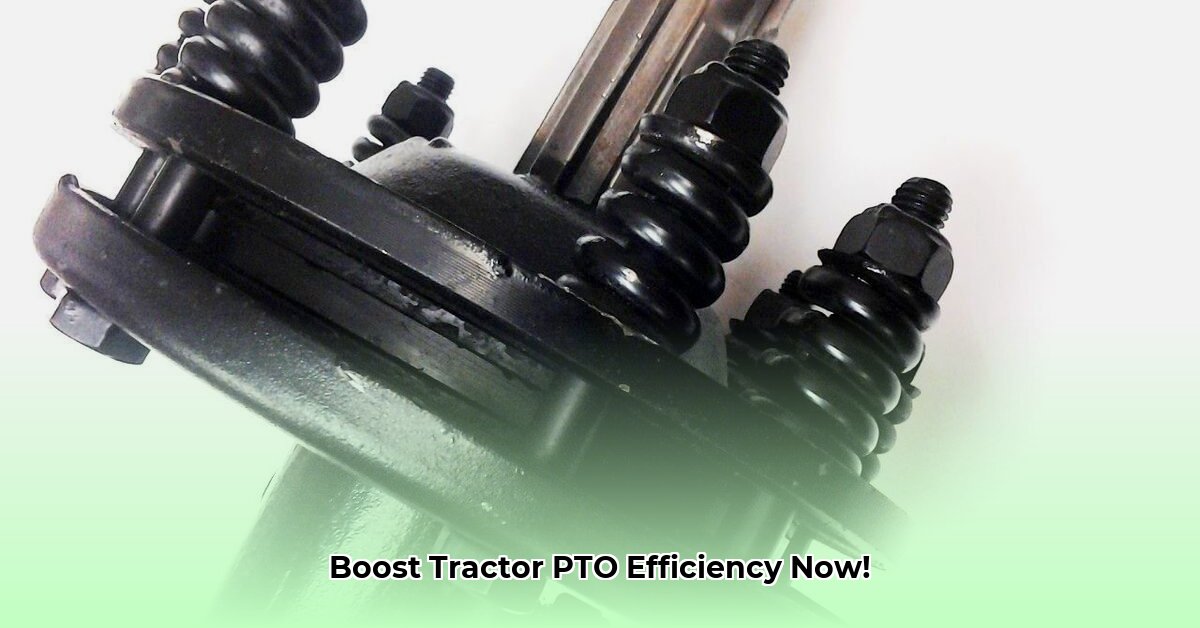
Understanding Your Tractor PTO Slip Clutch
A PTO (Power Take-Off) slip clutch is a critical safety device on your tractor, acting as a protective buffer between your tractor's power and the implement you're using (e.g., mower, baler, tiller). It prevents damage from sudden overloads or unexpected resistance. Think of hitting a rock while tilling—a slip clutch allows the implement's shaft to slip slightly, absorbing the shock and preventing broken driveshafts or gearbox damage. This saves you costly repairs and potential downtime. Isn't consistent uptime crucial for maximizing your farm's yield? For more information on tractor mechanics, check out this helpful resource on tractor drive systems.
Several types of slip clutches exist, each with advantages and disadvantages:
| Clutch Type | Advantages | Disadvantages |
|---|---|---|
| Mechanical | Simple, reliable, generally inexpensive | Can be abrupt, may require regular adjustment |
| Hydraulic | Smoother operation, adjustable slip torque | More complex, requires a functioning hydraulic system |
| Electromagnetic | Precise control, fast engagement/disengagement | Typically more expensive, potentially more complex to service |
Choosing the Right Slip Clutch for Your Tractor PTO
Selecting the proper slip clutch involves careful consideration of several factors. Neglecting these considerations can lead to equipment damage or inefficient operation.
First, your tractor's PTO horsepower is paramount. The clutch must be rated for at least this power, ideally with a slight margin for safety. You wouldn't want a clutch to fail in a critical operation.
Next, consider the implements you'll use. A heavy-duty plow needs a far more robust clutch than a light-duty lawn mower. Operating conditions also play a significant role. Rocky terrain or dense soil demands a clutch capable of withstanding higher stresses.
Finally, budget is a factor. Hydraulic clutches generally cost more than mechanical ones but offer smoother operation and more precise control. What's the best fit for your operation's needs and budgetary constraints?
Here's a general guideline of PTO HP needed for various implements:
| Implement | Approximate PTO HP Needed | Suggested Clutch Type(s) |
|---|---|---|
| Small Lawnmower | 15-25 HP | Mechanical |
| Medium-Duty Tiller | 30-45 HP | Mechanical or Hydraulic |
| Heavy-Duty Plow | 50-75 HP | Hydraulic |
| Large Round Baler | 75+ HP | Hydraulic or Electromagnetic |
Remember, always consult your tractor and implement manuals for precise PTO horsepower recommendations. The chart above provides general estimates only.
Installing Your Tractor PTO Slip Clutch: A Step-by-Step Guide
Installing a slip clutch requires care and attention to safety. Improper installation can lead to malfunctions and safety hazards. While specific instructions vary depending on your clutch's make and model, the general process remains similar. Always refer to the manufacturer's instructions for your specific clutch model.
Step 1: Safety First! This cannot be overstated. Disconnect the PTO shaft completely. Engage the parking brake and ensure the tractor is completely turned off. Remove the ignition key.
Step 2: Alignment is Key: Carefully align the clutch with both the tractor's PTO shaft and the implement's input shaft. Precise alignment is critical to prevent problems and ensure proper function.
Step 3: Secure Mounting: Tighten all mounting bolts securely. After tightening, double-check the alignment one last time to avoid problems down the line.
Step 4: Test Run (Low Power): Before full-throttle operation, perform a low-power test run to verify proper engagement and confirm that the slip function works correctly. This step can prevent more significant issues later.
Keeping Your Slip Clutch in Top Shape: Maintenance Tips
Regular maintenance significantly extends your slip clutch's lifespan and ensures reliable performance.
- Regular Inspections: Conduct visual inspections for wear, damage, or leaks during routine maintenance checks. Early detection of small issues can prevent larger problems.
- Lubrication: Adhere strictly to the manufacturer's lubrication recommendations and schedule. Insufficient lubrication leads to premature wear.
- Adjustments (if applicable): Mechanical clutches may require periodic adjustment to maintain the correct slip torque. Consult your clutch's manual for specific instructions.
Troubleshooting Common Slip Clutch Problems
Even with proper maintenance, problems can occur. Here are some common issues and their possible causes:
- Clutch Slips Too Easily: This could indicate worn friction plates (mechanical clutches), low hydraulic pressure (hydraulic clutches), or improper adjustment.
- Clutch Won't Engage: This might signal a problem with the engagement mechanism, low hydraulic pressure, or a blockage in the hydraulic lines (hydraulic clutches).
- Clutch Engages Abruptly (Mechanical Clutches): Improper adjustment is the most likely culprit.
If you encounter any of these, consult your clutch's manual for troubleshooting guidance or seek help from a qualified mechanic. Avoid attempting complex repairs unless you possess the necessary expertise.
By following these guidelines, you can ensure your PTO slip clutch functions efficiently and safely, contributing to a more productive and less stressful operation. Remember, preventative maintenance and prompt repairs prevent costly downtime and extend the life of your equipment.